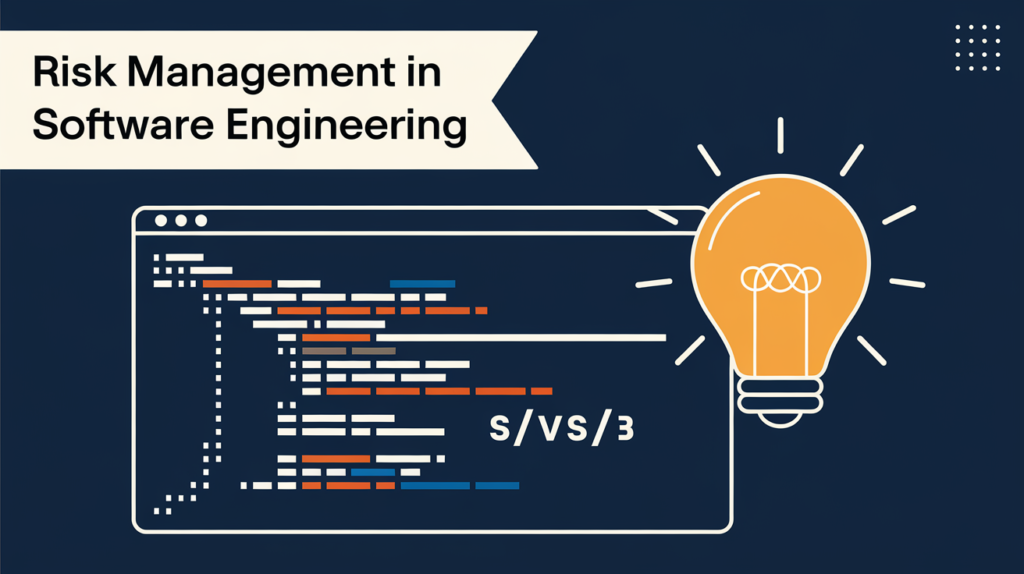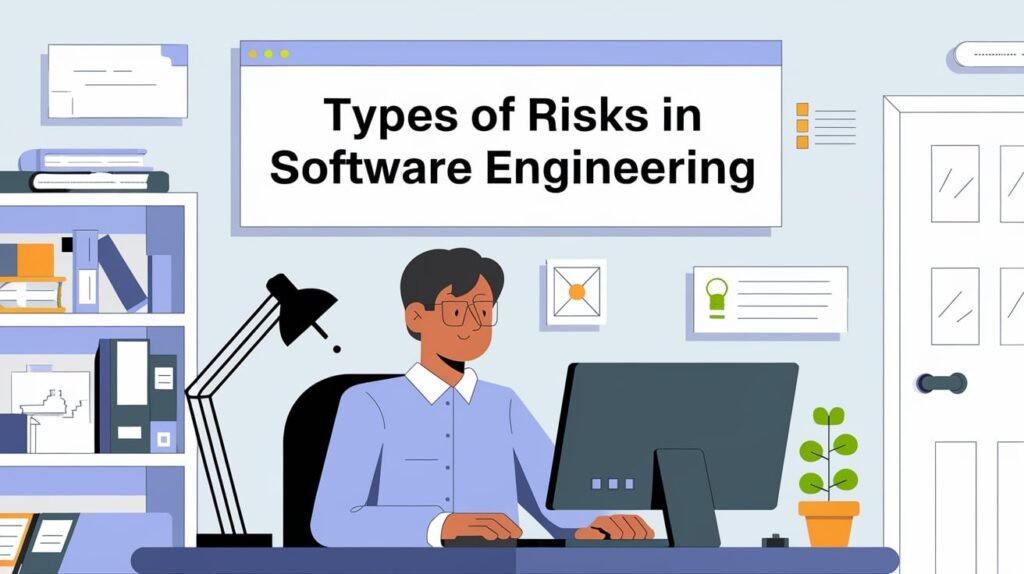
In the dynamic and ever-evolving world of software engineering, risk management plays a pivotal role in steering projects towards successful outcomes. This discipline, often overlooked, is essential in anticipating uncertainties that could potentially derail a project. But what exactly does risk management encompass in the realm of software engineering? It involves a systematic approach to identifying, evaluating, and addressing risks that could threaten the success of a software project. This article delves into the intricacies of risk management in software engineering, the diverse tools available, and the critical importance of thorough risk assessment to safeguard your projects.
Understanding Risk Management in Software Engineering
Risk management in software engineering is about being proactive rather than reactive. It’s about foreseeing potential issues that might arise during the software development lifecycle and preparing for them in advance. These issues, or risks, can be varied and complex, ranging from technical challenges like software bugs to external factors such as market fluctuations. By addressing these risks proactively, teams can mitigate negative impacts and significantly enhance the likelihood of project success.
The Importance of Early Risk Detection
Early detection of risks is crucial in software engineering. When risks are identified at the initial stages, the team can devise strategies to counteract them before they escalate. This foresight not only saves time and resources but also minimizes the chances of project failure. Early risk detection is akin to spotting an iceberg from afar, allowing the team to steer the project ship away from danger well in advance.
The Role of Risk Management in Agile Environments
In agile environments, where change is constant and rapid iterations are the norm, risk management becomes even more critical. Agile methodologies emphasize flexibility and adaptability, which can introduce new risks at every iteration. Therefore, integrating risk management into agile practices ensures that teams remain vigilant and responsive to emerging threats, maintaining the balance between agility and stability.
Balancing Risk and Innovation
While risk management is about mitigating potential issues, it should not stifle innovation. In software engineering, innovation often involves venturing into uncharted territories, which naturally brings risks. Effective risk management strikes a balance by allowing teams to innovate while keeping potential pitfalls in check. It’s about managing uncertainties without curbing creativity, enabling groundbreaking advancements while safeguarding project objectives.
Types of Risks in Software Engineering

Software engineers encounter a plethora of risks that can impact project success. Understanding these risks is the first step towards effective risk management.
Technical Risks
Technical risks are inherent in the technology stack chosen for the project. These risks can manifest when a chosen technology becomes obsolete or fails to meet the project’s requirements. For instance, relying on a third-party library that is no longer supported can jeopardize the entire project. Additionally, performance issues, compatibility problems, and integration challenges also fall under technical risks, requiring constant vigilance and adaptability from the development team.
Project Management Risks
Project management risks arise from issues related to planning, execution, and control of the project. Misestimating timelines, underallocating resources, or failing to adhere to the project plan can lead to delays and cost overruns. Communication gaps, unclear objectives, and inadequate stakeholder engagement further exacerbate these risks. Effective project management practices, such as clear communication channels and realistic scheduling, are vital to mitigating these risks.
Organizational Risks
Organizational risks stem from the internal dynamics of the company. These include changes in management, restructuring, or shifts in company policy that can affect the project’s direction. Organizational culture also plays a role; a culture resistant to change can hinder the implementation of necessary risk management practices. Understanding and aligning with organizational goals and fostering a risk-aware culture are essential for minimizing these risks.
External Risks
External risks originate from outside the organization and are often beyond the team’s control. These include changes in market trends, economic conditions, regulatory requirements, or even geopolitical factors. For instance, a sudden change in data protection laws can necessitate significant adjustments in a software project. Staying informed about industry developments and maintaining flexibility in project plans are key strategies to address external risks.
The Risk Management Process in Software Engineering

The risk management process is a structured approach that guides teams in identifying and handling risks effectively. It comprises several critical steps that ensure comprehensive risk oversight.
1. Risk Identification
Risk identification is the cornerstone of the risk management process. This step involves a thorough examination of the project environment to uncover potential risks. Input from diverse sources, including team members, stakeholders, and historical project data, is invaluable. Techniques such as brainstorming sessions, SWOT analysis (Strengths, Weaknesses, Opportunities, Threats), and checklists can facilitate the identification process. By cataloging all possible risks, teams can lay the groundwork for effective risk management.
2. Risk Assessment
Once risks are identified, assessing their potential impact and likelihood becomes imperative. This assessment helps prioritize risks based on their severity and probability, allowing the team to focus on those that pose the greatest threat. Tools such as risk assessment matrices and probability-impact graphs provide visual representations of risk severity, aiding in decision-making. This step ensures that the team allocates resources efficiently to address the most pressing risks.
3. Risk Mitigation
Risk mitigation involves devising strategies to reduce the likelihood or impact of identified risks. This could entail revising project plans, reallocating resources, or adopting new technologies. Contingency plans are also developed to prepare for scenarios where risks materialize despite preventive measures. The goal is to create a robust safety net that minimizes disruptions and keeps the project on track, even in the face of unforeseen challenges.
4. Risk Monitoring and Review
Risk management is not a one-time task but an ongoing process. Regular monitoring and review of risks ensure that the team remains vigilant and responsive to new threats. This involves updating risk management plans, reassessing risks, and communicating changes to all stakeholders. Continuous monitoring fosters a proactive risk management culture, allowing teams to adapt swiftly to evolving project dynamics.
Tools for Risk Management in Software Engineering

Effective risk management in software engineering is bolstered by a variety of tools designed to streamline the process. These tools offer practical solutions for identifying, assessing, and addressing risks.
Risk Management Software
Dedicated risk management software like RiskWatch and Active Risk Manager provide comprehensive platforms for handling risks. These tools offer features such as risk assessment matrices, reporting capabilities, and integration with project management software. They enable teams to track risks systematically, ensuring that no potential threat goes unnoticed. By automating risk management tasks, these tools free up valuable time for teams to focus on strategic decision-making.
Project Management Tools
General project management tools such as Jira, Trello, and Asana also play a crucial role in risk management. These tools facilitate task tracking, deadline management, and resource allocation, all of which are vital for implementing risk mitigation strategies. By providing a centralized platform for project oversight, they help teams stay organized and ensure that risk-related tasks are executed efficiently.
Communication Tools
Effective communication is the backbone of successful risk management. Tools like Slack or Microsoft Teams enhance collaboration among team members, making it easier to discuss and address risks promptly. These platforms support real-time communication, file sharing, and integration with other tools, fostering a seamless flow of information. By facilitating open dialogue, communication tools ensure that all team members are informed and aligned on risk management efforts.
Benefits of Effective Risk Management
Implementing a robust risk management strategy in software engineering projects yields numerous benefits that can significantly enhance project outcomes.
Improved Project Outcomes
By identifying and mitigating risks early, projects are more likely to stay on schedule and within budget. Early risk detection allows teams to address potential issues before they escalate, minimizing disruptions and ensuring a smoother project execution. This proactive approach enhances project reliability and increases the likelihood of delivering a successful product.
Enhanced Decision-Making
A clear understanding of potential risks empowers teams to make informed decisions. By having a comprehensive view of the project landscape, teams can prioritize tasks effectively and allocate resources where they are needed most. This informed decision-making process enables teams to adapt to changing circumstances and maintain project momentum.
Increased Stakeholder Confidence
Demonstrating a proactive approach to risk management boosts stakeholders’ confidence in the project’s success. Stakeholders appreciate transparency and assurance that risks are being managed effectively. By showcasing a well-structured risk management strategy, teams can build trust and foster positive relationships with stakeholders, enhancing collaboration and support for the project.
Better Resource Management
Anticipating risks allows teams to allocate resources more efficiently. By understanding potential challenges, teams can ensure that the right people and tools are available when needed. This foresight prevents resource bottlenecks and optimizes resource utilization, contributing to the overall efficiency and success of the project.
Challenges in Risk Management
Despite its numerous benefits, risk management in software engineering presents several challenges that teams must navigate to achieve success.
Inaccurate Risk Assessment
Estimating the impact and likelihood of risks is inherently challenging. Inaccurate assessments can lead to misprioritization, where critical risks are overlooked or minor risks are given undue attention. To mitigate this challenge, teams must leverage data-driven approaches, historical insights, and expert judgment to enhance the accuracy of risk assessments.
Resistance to Change
Implementing risk management strategies often requires changes to established processes and practices. Teams may resist these changes, especially if they perceive risk management as an additional burden. Overcoming resistance involves fostering a risk-aware culture, emphasizing the benefits of proactive risk management, and gaining buy-in from all team members.
Resource Constraints
Limited resources can hinder the ability to address all identified risks, forcing teams to prioritize. Budget constraints, time limitations, and manpower shortages can impede comprehensive risk management efforts. To address this challenge, teams must adopt a strategic approach, focusing on high-impact risks and leveraging available resources efficiently.
Conclusion
Risk management is a vital component of successful software engineering projects. By understanding the types of risks involved, following a structured risk management process, and utilizing appropriate tools, teams can effectively mitigate risks and improve project outcomes. While challenges exist, the benefits of proactive risk management far outweigh the difficulties, making it a worthwhile investment for any software engineering team. In a rapidly changing technological landscape, risk management serves as a guiding compass, steering projects toward success amidst uncertainty.
Leave a Reply